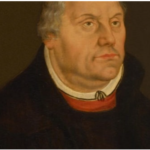Biography of Martin Luther: The Reformist
Martin Luther was born to peasant stock on November 10, 1483 in Eisleben in the Holy Roman Empire – in what is today eastern Germany. Soon after Luther’s birth, his family moved from Eisleben to Mansfeld. His father was a relatively successful miner and smelter and Mansfeld was a larger mining town. Martin was the second son born to Hans and Magarete (Lindemann) Luther. Two of his brothers died during outbreaks of the plague. One other brother, James, lived to adulthood. Luther’s father knew that mining was a cyclical occupation, and he wanted more security for his promising young son. Hans Luther decided that he would do whatever was necessary to see that Martin could become a lawyer. Hans saw to it that Martin started school in Mansfeld probably around seven. The school stressed Latin and a bit of logic and rhetoric. When Martin was 14 he was sent to Magdeburg to continue his studies. He stayed only one year in Magdeburg and then enrolled in Latin school in Eisenach until 1501. In 1501 he enrolled in the University of Erfurt where he studied the basic course for a Master of Arts (grammar, logic, rhetoric, metaphysics, etc.). Significant to his spiritual and theological development was the principal role of William of Occam’s theology and metaphysics in Erfurt’s curriculum. In 1505, it seemed that Han’s Luther’s plans were about to finally be realized. His son was on the verge of becoming a lawyer. Han’s Luther’s plans were interrupted by a thunderstorm and vow. In July of 1505, Martin was caught in a horrific thunderstorm. Afraid that he was going to die, he screamed out a vow, “Save me, St. Anna, and I shall become a monk.” St. Anna was the mother of the Virgin Mary and the patron saint of miners. Most argue that this commitment to become a monk could not have come out of thin air and instead represents an intensification experience in which an already formulated thought is expanded and deepened. On July 17th Luther entered the Augustinian Monastery at Erfurt. The decision to enter the monastery was a difficult one. Martin knew that he would greatly disappoint his parents (which he did), but he also knew that one must keep a promise made to God. Beyond that, however, he also had strong internal reasons to join the monastery. Luther was haunted by insecurity about his salvation (he describes these insecurities in striking tones and calls them Anfectungen or Afflictions.) A monastery was the perfect place to find assurance. Assurance evaded him however. He threw himself into the life of a monk with verve. It did not seem to help. Finally, his mentor told him to focus on Christ and him alone in his quest for assurance. Though his anxieties would plague him for still years to come, the seeds for his later assurance were laid in that conversation. In 1510, Luther traveled as part of delegation from his monastery to Rome (he was not very impressed with what he saw.) In 1511, he transferred from the monastery in Erfurt to one in Wittenberg where, after receiving his doctor of theology degree, he became a professor of biblical theology at the newly founded University of Wittenberg. In 1513, he began his first lectures on the Psalms. In these lectures, Luther’s critique of the theological world around him begins to take shape. Later, in lectures on Paul’s Epistle to the Romans (in 1515/16) this critique becomes more noticeable. It was during these lectures that Luther finally found the assurance that had evaded him for years. The discovery that changed Luther’s life ultimately changed the course of church history and the history of Europe. In Romans, Paul writes of the “righteousness of God.” Luther had always understood that term to mean that God was a righteous judge that demanded human righteousness. Now, Luther understood righteousness as a gift of God’s grace. He had discovered (or recovered) the doctrine of justification by grace alone. This discovery set him afire. In 1517, he posted a sheet of theses for discussion on the University’s chapel door. These Ninety-Five Theses set out a devastating critique of the church’s sale of indulgences and explained the fundamentals of justification by grace alone. Luther also sent a copy of the theses Archbishop Albrecht of Mainz calling on him to end the sale of indulgences. Albrecht was not amused. In Rome, cardinals saw Luther’s theses as an attack on papal authority. In 1518 at a meeting of the Augustinian Order in Heidelberg, Luther set out his positions with even more precision. In the Heidelberg Disputation, we see the signs of a maturing in Luther’s thought and new clarity surrounding his theological perspective – the Theology of the Cross. After the Heidelberg meeting in October 1518, Luther was told to recant his positions by the Papal Legate, Thomas Cardinal Cajetan. Luther stated that he could not recant unless his mistakes were pointed out to him by appeals to “scripture and right reason” he would not, in fact, could not recant. Luther’s refusal to recant set in motion his ultimate excommunication. Throughout 1519, Luther continued to lecture and write in Wittenberg. In June and July of that year, he participated in another debate on Indulgences and the papacy in Leipzig. Finally, in 1520, the pope had had enough. On June 15th the pope issued a bull (Exsurge Domini – Arise O’Lord) threatening Luther with excommunication. Luther received the bull on October 10th. He publicly burned it on December 10th. In January 1521, the pope excommunicated Luther. In March, he was summonsed by Emperor Charles V to Worms to defend himself. During the Diet of Worms, Luther refused to recant his position. Whether he actually said, “Here I stand, I can do no other” is uncertain. What is known is that he did refuse to recant and on May 8th was placed under Imperial Ban. This placed Luther and his duke in a difficult position. Luther was now a condemned and wanted man. Luther hid out at the Wartburg Castle until May of 1522 when he returned to Wittenberg. He continued teaching. In 1524, Luther left the monastery. In 1525, he married Katharina von Bora. From 1533 to his death in 1546 he served as the Dean of the theology faculty at Wittenberg. He died in Eisleben on 18 February 1546.





